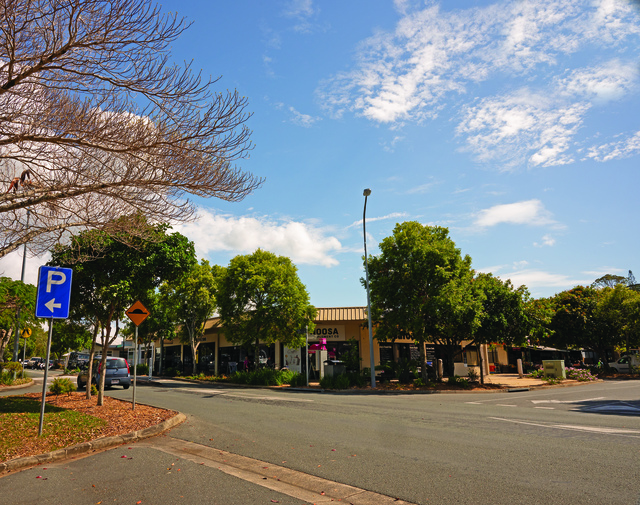The State Government’s new fast-tracked State Facilitated development (SFD) assessment pathway is supposed to provide faster decisions and resolution of planning and infrastructure issues to provide housing, including social and affordable homes. A high-density, high rise, commercial, retail and residential (195 unit) development has been proposed for Noosa Junction, and a high density (40 unit) residential development proposed for Tewantin.
Much of Noosa’s existing tourism, environmental, commercial, industrial and residential hub has already been overloaded. These were emerging issues back in 1984 when finalising the 1984 Noosa Planning Scheme and associated policies as Noosa Shire Council’s Acting Shire Planner/Strategic Planner/Special Projects Officer.
Severe traffic congestion and parking issues have been evident throughout Noosa for many years, so increasing the population in any form will create more congestion. Over 6 years ago (5 May 2018), when Council increased motor bike parking spaces in Hastings Street, Motor Bike News reported that Noosa is notorious for its traffic and parking problems and that in busy tourist seasons, it is not uncommon for traffic to be tailed back 1km to the main street.
It is common knowledge that tourism has transformed many once-pristine destinations like Noosa into bustling hubs of activity. While this commercialisation and population growth can bring economic benefits, it often results in the degradation of the very qualities that made these places attractive in the first place. Concern have been expressed that the possibility looms of high rise units being forced onto Noosa by the State Government, and will this change the character of Noosa forever much like it has in Maroochydore (The Editor (Noosa Today – 20 Sep 2024). At times there is already standing room only at main beach Noosa and on the footpaths of the Noosaville Noosa River foreshore.
In Barcelona, Spain, the locals aren’t happy and they’ve taken to the streets to demand that tourists go home. They want a city for citizens and not in service of tourists. Barcelona plans to shut all holiday apartments by 2028 as the mayor seeks to tackle housing crisis (ABC News Daily 5 August 2024. Even some expats who were attracted to Bali’s slower pace of life are planning to leave. There’s more traffic now, and it has become more westernized, crowded, expensive and too touristy; rents have risen dramatically making it harder for local people to afford their lifestyles (Business Insider 24 Sep 2024).
The two SFD development proposals provide no site design details, traffic or carparking impact surveys. There are no architectural details, aesthetic or visual impact analysis, and no details as to how “planning and infrastructure issues” are to be resolved. Mayor Frank Wilkie reports that the new pathway, which has no application fees and is funded by taxpayers, allows developers to circumvent council assessment.
Not surprisingly, there has been a strong public reaction as outlined in Noosa Today (Opposition Rising- Noosa Today -20 Sep 2024) by Peter Wellington and others against the State Government’s Martial law type intervention to the normal planning processes for development proposals. Martial law is the replacement of civilian government by military rule and the suspension of civilian legal processes for military powers. Most often, declared in times of war and/or emergencies such as civil unrest and natural disasters.
The proposed State Facilitated Development site at 2, 6, 8, 10 and 12 Lanyana Way and 28 Sunshine Beach Road, Noosa Heads comprising of about 27% of the existing Noosa Junction Shopping Centre between Lanyana Way and Sunrise Beach Road, is to be developed for high-density, high rise, commercial, retail and residential (195 unit) development. The bulk of the proposal is in Lanyana Way between the Noosa Transit Centre carpark and Franks Gymnasium, and includes the Noosa Junction Seafood Market, Pardons Fruit Market, Noosa Dental Services, Lexis English School, QML Pathology, Vanilla Food, Nillar’s Pantry, Domini Collective, Williamson & Co Real Estate and others, and the Sun Centre in Sunrise Beach Road.
The Noosa Junction Shopping Centre has been developed in a flat part of a valley on the downslopes from Bottlebrush Avenue, generally following the natural contours of the land. The reported seven storey SFD development would visually conflict with the established, essentially two storey-built form of the shopping centre and would screen the surrounding hillside vegetation. The Noosa Central building and the Professional Centre have two storeys with basement type parking underneath. Resolving the car parking configuration and access requirements for the proposed development’s residents, traders and customers and integration into the existing road/parking pattern would be a major exercise. Even with reduced car parking spaces for the units as proposed under planning scheme amendments there would potentially be an additional 395 residents, placing pressures on already overloaded tourist and recreational public spaces.
The proposed State Facilitated Development site at 87-89 Poinciana Avenue and 10 Sidoni Street, Tewantin, on the south-western corner of Poinciana Avenue and Sidoni Street, is directly opposite the Atrium shopping mall and next to the Department of Transport and Main Roads Customer Service Centre. The site and surrounding areas including the intersection’s roundabout, the road reserves and nearby Ward Park are characterised by generous tree cover. Quite a picturesque, village setting and approach to the Tewantin Shopping Centre.
The site fronts a major traffic route and one of the most long-term congested traffic areas in Noosa with traffic regularly banking up to the Cemetery in morning peak hour traffic and the Poinciana Avenue/Butler Street roundabout at times dead locked with parked vehicles. There is virtually no street parking available in Sidoni Street, Donella Street and Poinciana Avenue due to existing heavy parking demands. Although the Tewantin (Beckmans Road) Bypass Stages 2 & 3 have been earmarked for fast tracking (Sandy Bolton-Annual Connect 2024 report), there is no guarantee that it will solve the congested traffic conditions in Tewantin and will most likely increase congestion in the Noosaville Industrial area around the Eumundi Noosa Road.
The Development details provided state that the proposal will have about 40 residential units and on-site car parking with at least 15% of the housing dedicated as affordable. This development density equates to 3.4 times the density of adjoining and nearby modern two-storey unit development. Any development, most likely over two-storeys, would disrupt the essentially two-storey buildings (including The Atrium) other than the two centrally located three storey buildings (The Cooloola Centre and the Tewantin Plaza at the rear) in both the Tewantin shopping/commercial precinct and adjacent residential areas.
As pointed out by Peter Wellington “Noosa has a long and proud history of preventing high-rise buildings”. Major changes to development criteria such as height and densities would need to be analysed in conjunction with visual impact, traffic and car parking studies etc. and carefully considered through the normal planning scheme amendment process involving meaningful public participation, and not through some hasty, fast-tracked process with no details.
In response to the proposed State Facilitated Development Notices issued for the two development sites, interested persons were invited to complete a survey to share their perspective on the sites being declared as a State Facilitated Development site. The survey questions could apply to any development site. The opportunity to complete the two surveys have already closed. In the absence of any development details and related impact assessments, responses to the survey questions would amount to general opinions at best. The Tewantin State Facilitated development proposal (3-4 storeys) was approved yesterday by the State Government.
Council’s Strategy and Environment Director Kim Rawlings has already stated that Noosa was well on track to meet its housing targets as set by the State and was working with the State and a Community Housing Provider. Therefore, there is no urgency or need for the new draconian fast-tracked State Government Facilitated development assessment process.
Councillor Brian Stockwell in a substantial article titled “We need a plan we can all share” Noosa Today 11/08/2024 writes that we must use our opportunities to rebalance development to give our lower paid workers, struggling families and older residents a chance. Wow! This is a high calling. I didn’t know this was a Local Government responsibility. It’s not spelt out in the Noosa Planning Scheme or in any preamble that I have seen. And all this at the point of a State Government gun – ‘Do your bit, or we will do it for you’.
So, how did we get into this mess? Well, the picture is getting a little bit clearer. I have since learned that governments are starting to impose taxes on Airbnb uses, starting to get rid of Short-Term Accommodation uses because they are driving up rents and contributing to housing market shortages. Barcelona plans to shut all holiday apartments by 2028 (all 10,000 of them) as the mayor seeks to tackle the housing crisis. Some residents cannot afford an apartment after rents rose 68 per cent in the past 10 years and the cost of buying a house rose by 38 per cent (ABC News 22 June 2024). So why is Noosa Shire Council supporting short term accommodation and why are we being asked to change our established lifestyles and established planning regulations with increased building heights, increased development densities and reduced car parking requirements in proposed planning scheme amendments.
Perhaps a salary rise would be more appropriate for the low-income earners as a lot of the jobs in the hospitality and aged care industry are very demanding. Perhaps other areas of Noosa Shire should be considered for affordable housing and the uniqueness, physical, environmental and built fabric of the Noosa tourist hub and surrounds given due recognition.
By chance, a resident in Noosa Heads living in the medium density zone recently discovered that proposed planning regulation changes may not allow a single detached house on the property should fire destroy the existing home and that the site and neigbouring properties could be developed for units as small as 75 square meters in area and potentially impact on the liveability and social fabric of the neighbourhood. Over 1000 residents have since objected to the proposal. Council did not apparently advise affected residents of the proposal as required under the Integrated Planning Act. Does this invalidate the whole amendment process?
In Councillor Stockwell’s opinion we must take heed of the current external pressures and demonstrate how we can sustainably manage growth in a way that retains our community values without the need for intervention from higher levels of government. He then discusses the story behind the height controls in Noosa, and his support in 1988 as a Councillor to reduce the maximum number of storeys from six to four in the Tourism accommodation zone and thus maintaining the built environment below the tree line.
He states that the Planning Scheme amendments propose to offer an incentive for developers wishing to include a percentage of social and affordable housing in the Junction and the Noosa Business Centre to go up to that limit for residential development, subject to building design parameters to achieve the sort of high quality outcomes we need for these areas. The aim is to relieve the current critical shortage in small and affordable housing. Just like the lack of details in the proposed SFD development proposals, Councillor Stockwell does not provide any details of the “high quality building design parameters” or indicate that a visual assessment analysis would be required.
It is irrational, to state as he did, that if it’s good enough for tourists to stay in four storey buildings, then it’s good enough for the rest of our residents. It is also ridiculous to talk about sustainably managing growth when we have already exceeded our capacity and affected community values.
He acknowledges that exceeded traffic capacity was recognised in 1997 and suggests that while some of this is from Noosa population growth, the increase in day tripping visitors from the growth elsewhere in SEQ is probably the main culprit (Noosa Today (11/08/2024). During weekday morning traffic peaks the so called “culprits” are actually locals going to work, moms and dads driving their kids to school.
Councillor Brian Stockwell mentions that amendments to the planning scheme include specific provisions to address the issue, in part, by reducing the need for private cars by increasing dwellings in highly connected centres, and that the proposed changes to car parking requirements are based on advice of experts in the field and reflect successful initiatives elsewhere in Australia.
Again, he did not provide any details of these proposed changes. It appears that 1 car parking space is to be provided for units between 75 and 100 square metres and 1 visitor space for every 4 units. There is no mention of any street parking availability survey, the estimated or likely number of persons per unit, or the number of bedrooms permitted in each unit.
Proposals to reduce or eliminate parking requirements for apartments in Sydney and Melbourne are based on surveys showing that in many apartment developments car parking areas were under-utilised. Victoria’s Department of Transport and Planning could see existing minimum parking space requirements removed for new apartment buildings built near public transport hubs. High public transport accessibility levels (PTAL) would apply to areas within or next to Melbourne’s city centre and some major suburban and regional centres with good access to multiple types of public transport, i.e. to those within a short walk of a train, tram or bus route with good service frequency.
Car parking requirements will be cut at new inner city builds as part of the Brisbane City Council’s plans to boost supply and increase affordability for developers and buyers alike. High public accessibility levels would not be possible in small distant locations such as Noosa and where there is already pressure on limited on-street parking.
A professor in tourism at the Copenhagen Business School in Denmark with expertise on overtourism and on the relationship between tourists and residents says that a combination of solutions is needed like demarketing campaigns in the Netherlands, especially with Amsterdam to get rid of certain types of tourists. Then there is caps on tourists, there’s taxes some cities are bringing in. He adds that prices go up, people cannot afford to live in the apartments anymore. Even people working in tourism. He says that overtourism creates a crowding or a capacity problem. He thinks the biggest part of overtourism is the gentrification issue, that more and more that just the big companies get the money, that people are working in the industry for minimum wages, which is not enough to live anymore with the increasing prices (ABC News Daily 5 Aug 2024).
So, is it time to de-escalate? There are incendiary questions to ask in Noosa: do we need to develop upwards – even a little bit – and if we do, is there a long term cost to the Noosa we have fought so hard for (Noosa: the high stakes of going up: Rick Jay Noosa Matters, 17 Aug 2024). Or should we continue to pack our finite and congested Noosa main beach and National Park, Noosaville foreshore recreation and tourist areas with even more people and cars. We seem to be doing a good job at this by offering free bus trips, introducing high tech controls to enforce parking limits, and increasing our population.
Even Council’s current draft Noosaville Foreshore Infrastructure Master Plan documentation states that a rejuvenated foreshore will likely attract more people. However, a Parking Management Plan for key areas of Noosa such as Noosaville will be undertaken after the Master Plan, i.e., after the horse had bolted.
(Johann Holdysz, a Tewantin resident, is a former Acting Shire Planner (9 months), Strategic Planner & Special Projects Officer – Noosa Shire Council, former Acting Principal Town Planner – Department of Housing Qld 1994/1995, Victorian Government appointed technical advisor and steering committee member: – PLANNING OPPORTUNITIES ALONG THE MARIBYRNONG RIVER, MELBOURNE METROPOLITAN BOARD OF WORKS – A guide for the future planning along the Lower Maribyrnong River, published in May 1982.)








